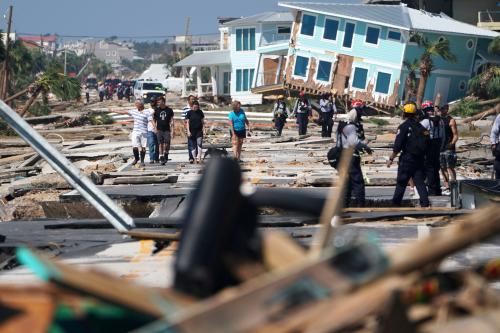A year ago, the federal government shut down for two days. No, this wasn’t over political budget squabbles but, rather, because Superstorm Sandy was barreling toward Washington. THAT shutdown seemed like a good idea.
Fortunately, metropolitan Washington was largely spared, especially considering the widespread devastation the storm inflicted upon New York and New Jersey. The nearly $50 billion in damage Sandy caused left many grappling with how to better prepare communities for increasingly hostile weather events.
Looking back, we see many communities have still not fully recovered from the destruction. Nevertheless, several different organizations and initiatives, as well as cooperative efforts between different government levels have undeniably accomplished much to address the destruction. Importantly, a wider dialogue has also flourished that has centered on resilience to climate change.
Public and private leaders at all levels are looking for solutions to several problems posed by climate change, including rising sea levels. However, planning disaster recovery alone is not a viable option for governments cognizant of an increase in weather-related disasters in the coming years.
As such, cities, metropolitan areas, and regions across the country are beginning to embrace resilience—that is, preparing cities to better anticipate disasters instead of focusing on recovery and relief efforts after disaster has struck—as the new planning norm. And for good reason, the Federal Emergency Management Agency shows that for every $1 that communities invest in resilience, $4 can be spared in damage that would otherwise be caused by a disaster.
On the federal level, the Obama administration’s Climate Action Plan, informed in part by the Sandy’s destruction, outlined several measures designed to increase community resilience, including the formation of a task force made up of both federal and local leaders dedicated to “climate preparedness.” The task force provided recommendations to the federal government on how to improve the transfer of money from grant and loan programs into recovery efforts, underscoring the importance of local authorities as first in line for disaster response.
In August, the Hurricane Sandy Rebuilding Task Force issued important guidelines for the expenditure of federal funds for local recovery priorities. They demonstrated an unprecedented commitment to coordination across federal agencies and collaboration between the federal, state, and local governments and key local constituencies. Instead of establishing new programs with restrictive statutory provisions, the task force recommends (and has already begun to implement) new locally-driven solutions through innovative competitions—such as Rebuild by Design—and added flexibility for communities to decide how funds can be best spent within and across jurisdictions.
Grants and loan programs have also sprung out to aid homeowners and businesses in their reconstruction efforts, facilitating a quicker return to normalcy after Sandy’s devastation. For example, grants under the Reconstruction, Rehabilitation, Elevation, and Mitigation Program of up $150,000 are being distributed to help homeowners re-build. Federal level initiatives underscored the importance of coordination of resources and efforts with state and local level stakeholders.
New York City’s resilience plan outlines plans to strengthen dune systems and establish surge barriers, a network of bulkheads, flood walls, and other safeguards on waterfront properties. New building codes were of particular importance to the Mayor Bloomberg, who scheduled the codes to go into effect a week after the report was published in June. The building codes require areas to be elevated two feet above a 100-year flood line and homes that were destroyed or damaged by Sandy must comply. However, larger, more expensive infrastructure changes such as building sea walls that would protect metropolitan New York from floods in the future have not been pursued by the mayor, who dismissed them as too expensive and environmentally unsustainable.
The property damage that Sandy inflicted also forced homebuilders to incorporate more resilient design in home construction methods, especially for vulnerable shoreline properties. Construction companies in New Jersey are using much stronger foundations by way of steel pillars, known as helical piles. The piles are drilled about 25 feet underground, until solid soil is reached. Additionally, some rebuilt homes leave the first one to two stories unoccupied—the parts of homes that are most prone to flooding.
Beyond technical infrastructure improvements are the philanthropically-supported efforts to boost civic infrastructure. Recovery and resiliency agents are being recruited for the purpose of helping municipalities navigate state, federal, and non-profit resources to assist in resiliency planning. The goal is to develop and deploy of the next generation of best practices for resiliency to climate change.
These efforts to boost New York and New Jersey’s post-Sandy resiliency represent a new form of creative public-private responses. But given the age of our infrastructure and the fact that most of our communities are still not designed for resiliency, much more will need to be done to make sure these innovations become the rule, rather than the exception.
Esperanza Guevara contributed to the writing of this article.



Commentary
Recovery and Rebuilding After Superstorm Sandy: Looking Back
October 28, 2013